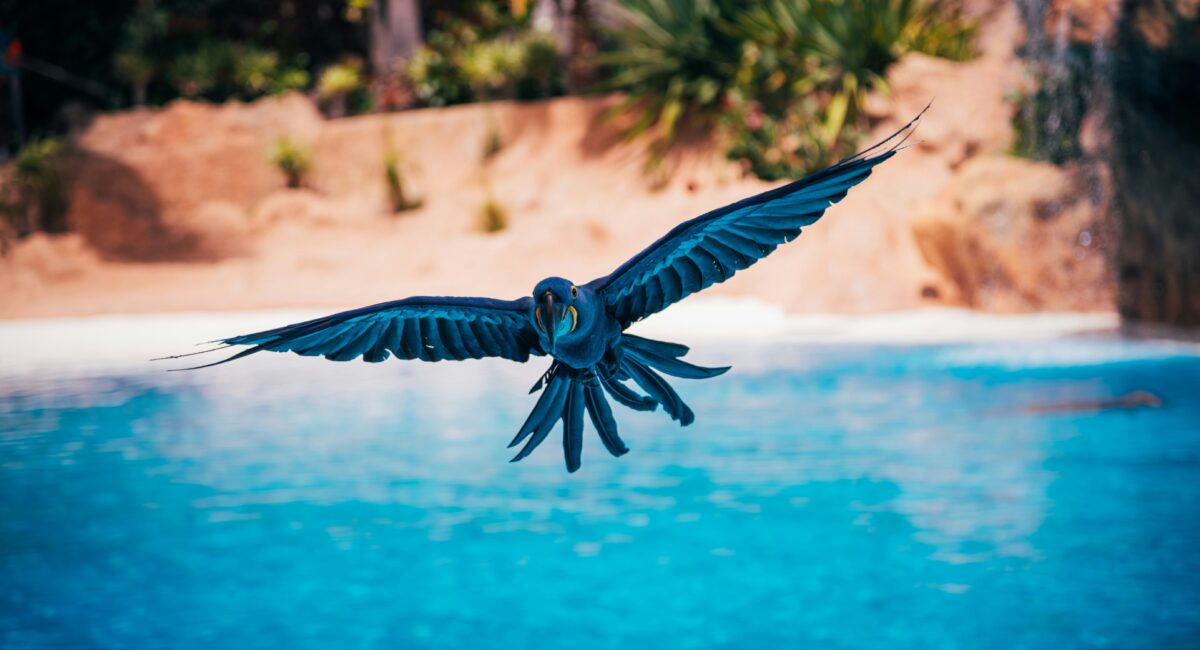A Complete Profile of the Rare Blue Spix’s Macaw
Spix’s Macaw, Scientifically known as Cyanopsitta Spixii, is a small to medium size blue parrot that comes from the Psittacidae family of true parrots. They are truly magnificent and have captured my heart alongside many other bird lovers and conservationists.
Spix’s Macaw is one of the rarest bird species in the world. They have faced a number of challenges throughout history and have almost faced extinction. This article will give you a better understanding about a complete profile of the rare blue Spix’s Macaw and everything you need to know about them.
—————————————————————————————————-
Length: 21 – 23 inches
Weight: 300 – 450 grams
Color: Azure blue
Personality Traits: Affectionate, Social, Intelligent
Characteristic: Mostly azure blue with a darker tint on their wings and tail and a lighter tint on their face, neck, and underbelly.
Lifespan: 28 – 40 years
Location: Dry tropical forests near streams in Brazil
———————————————————————————————
Origin and History
The Spix’s macaw is native a bird to the Rio São Francisco region of Brazil, specifically the state of Bahia. These birds can be located or found near riparian forest or riparian woodland areas which are near rivers and streams. These forests are good for them because they usually provide good nesting areas and foods.
Spix’s Macaw was first discovered in 1638 by a German naturalist by the name of Georg Marcgrave when he was working in the State of Pernambuco. It was until later in 1819 they were rediscovered by a German naturalist named Johann Baptist von Spix, whom the bird is named after. Their population severely declined due to destruction of their habitat, illegal pet trades, and agriculture expansion. Spix’s Macaw was declared extinct in the wild by the 20th century and is considered critically endangered. Nowaday there are conservation efforts that have been happening that focus on repopulating them and reintroducing them to the wild.
Characteristics
The Spix’s Macaw is a beautiful small to medium sized parrot that comes from Rio São Francisco of Brazil and they are quite the sight-seeing. They are measured around 55 cm (22 inches) in length, with a wingspan of approximately 30 cm (12 inches). The color of their body and wing is a bright azure blue with lighter shades of it on their head and underparts and their wings also have a tint of azure blue but a little darker. Their tail feathers are long and pointy and have the same properties of their wings and that being darker.
Temperament and Intelligence
Spix’s Macaws are social creatures, in the wild they are usually spotted in pairs or small groups as they form very strong bonds with their mates. Which is why the nature of Spix’s Macaw is very gentle and affectionate as they tend to spend a lot of time with their mate. They are very curious and playful and like to explore their environment, this could be climbing, playing with objects and toys or flying to new areas and discovering new things. They are also very intelligent shown by their problem solving skills and their ability to adapt to new environments or changes to the current environment.
Behavior and Communication
Just like many other parrots, Spix’s Macaws are very vocal. Their vocalization includes high-pitched squawks, whistles, and melodic calls. All of these vocalizations have different meanings from alarms, signals for mates or just to show their emotional state. They can also show body languages which vary from wing stretching, head bobbing, feather plucking, and more.
Learning their calls and vocalization can be beneficial as you can tell if your bird is happy, stressed or sick. Spix’s Macaw is also capable of imitating human speech or different bird speech by listening to sounds and learning. This is fantastic for someone who likes to train their birds. They can learn and develop a large vocabulary as compared to other birds. They also have a foraging behavior, this is when a pair or a small group feed together.
Diet and Nutrition
Diet and Nutrition is very important for the well-being of your bird. Spix’s Macaws diet primarily consists of seeds, nuts, and fruits. Having a balanced diet is very important as they can get all the essential components. A balanced diet should include carbohydrates (from seeds and fruits), proteins (from nuts and seeds), fats (from nuts), vitamins and minerals (from fruits and vegetable matter). Not to mention they should also get regular hydration in the form of fresh water, especially when they consume dry seeds and nuts. You should also give them any required supplement and minerals necessary for their health, this can be from vitamins, calcium, iodine etc.
Health and Environment
When owning a Spix’s Macaw you should always prioritize their health and a clean environment. Health issues or signs of health issues should be a major concern for the owner. To prevent health problems and illnesses you can keep a clean environment, have a healthy bird or vaccinate your bird. Boredom is another thing you should consider as parrots usually get bored. This can lead to stress and can also lead to more health problems.
Here are some common diseases and how you can spot them:
- Psittacine Beak: A very common infection that affects their beak and feathers. Sometimes it harms their immune systems. You might see feather loss, beak deformities, and may be secondary infection due to a poor immune system.
- Respiratory Infection: Common symptoms are sneezing, coughing, nasal discharge, and breathing difficulties.
- Obesity: Happens due to high in seed-mixes of their diet and low in fruits and vegetables. This can lead to liver disease and heart problems.
Early signs of any health problem should be a key to prevent any diseases from happening. Talk to your avian veterinarian for suggestions and help, if you do encounter a health problem.
Read Next:
The Most Common 5 Diseases Affecting Pet Birds
Habitat and Housing
Matching the habitat of Spix’s Macaw can be a reward task. Not only does this make the bird feel at home but it also adds an extra layer of realism and liveliness to your home aesthetic. With this in mind you should aim for spacious aviaries that can allow flight and room for physical activity.
An ideal aviary should be at least 20 feet long, 10 feet wide, and 10 feet high. You should always get non-toxic materials for your structure. You should also add natural items like branches, foliage, and nesting boxes to create a more stimulating environment. Also add a variety of toys and puzzles to sharpen their intelligence and avoid boredom, this can be from hiding food under leaves or adding a toy where they have to open it to get food, and other fun ideas. You should also control the humidity (around 50-60%) and temperature (ideally between 75-85°F (24-29°C)). of their environment. Always remember to check their water and food.
Training and Taming
Training takes time with any birds but before you can train your bird you must tame them. Taming is a simple but slow process. To start taming your bird you must let it get used to your presence. At first the bird will be scared of you but after a while they will know that you aren’t going to hurt and will be more relaxed with you. This step is only for those who haven’t hand fed their bird, as hand feeding usually leads to the bird trusting you from the beginning. But once you have completed this process you can start training them. You should always start slowly, for example let them walk on your finger and then give them positive reinforcement like treats or talk in a soothing voice. From this you can go into more advanced training like flying from a place to you or doing puzzles, and soon enough you will have an awesome trained bird. Remember this is a slow process and you need dedication and time to train a bird successfully.


